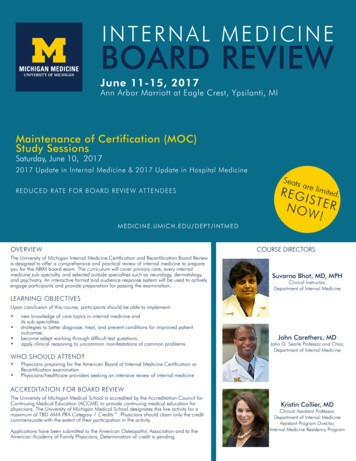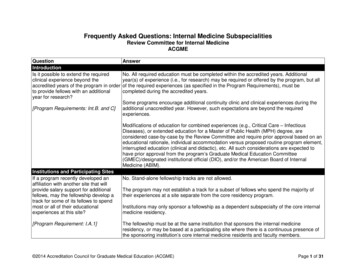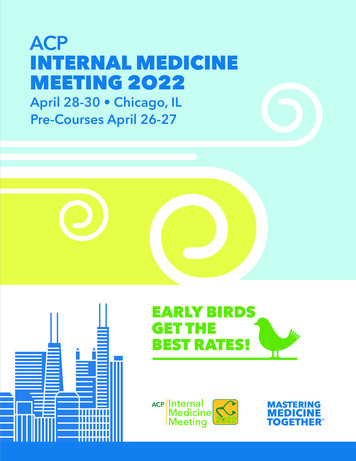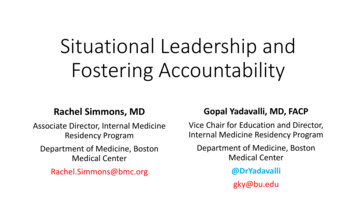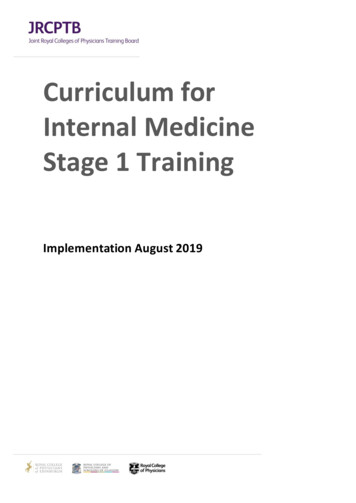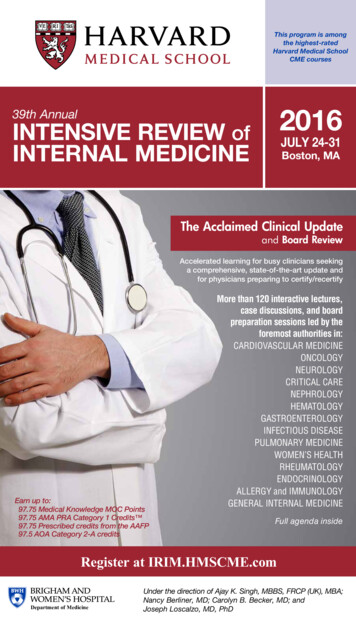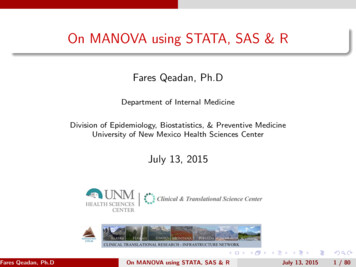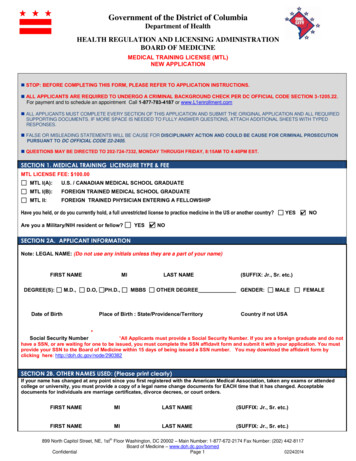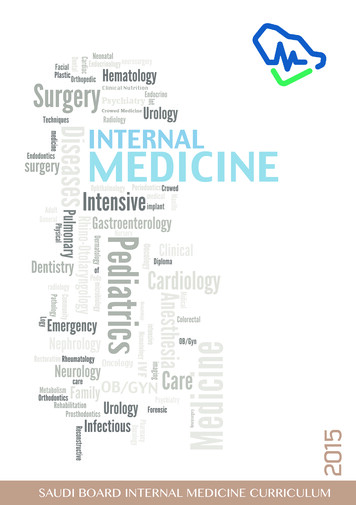
Transcription
SAUDI BOARDINTERNAL MEDICINE CURRICULUM2015PreparationCurriculum Scientific GroupPROF. ABDULLAH SALEH SHATOORDR. MOHAMMED AL FAIFIDR. FAHAD IBRAHIM AL SOHAIBANISupervisionCurriculum SpecialistsDR. AMIN ZUBAIRDR. ALSHAMARRI SAMIReviewed and ApprovedInternal Medicine ScientificCouncilDR. YOUSEF MOHAMMAD ALSALEHPROF. ABDULLAH SALEH SHATOORAL- GHAMDIDR. FAHAD IBRAHIM ALSOHABANIDR . KHALID AIDA ALSWAT1PROF. SAAD SALEHALSHOHAIBPROF. ABDULLAHKHALAF ALHWIESHDR.TARIG SALEHABDULLAH ALKHUWAITIRDR .TAWFIK KHALIDALBASSAMSAUDI BOARD INTERNAL MEDICINE CURRICULUMBRIG.GEN DR.MOHAMMADHUSSEIN ALFIFIDR. SAFWAN AHMED ZATARIDR . ABDULAZIZ A NWASSERALHERAIQIDR. SULAIMAN AHMEDKARSOU
COPYRIGHT AND AMENDMENTSAll rights reserved. 2015 Saudi Commission for Health Specialties.This material may not be reproduced, displayed, modified, or distributed without theprior written permission of the copyright holder.No other use is permitted without prior written permission of the Saudi Commission forHealth Specialties.For permission, contact the Saudi Commission for Health Specialties, Riyadh, Kingdom ofSaudi Arabia.Any amendment to this document shall be approved by the Specialty Scientific Counciland Executive Council of the commission and considered effective from the date theelectronic version of this curriculum published on the commission website wasupdated, unless a different implementation date is mentioned.P.O. Box: 94656Postal Code: 11614Contact Center: 920019393Website: www.scfhs.org.saDesigned and formatted:SALEM M ALTAMIMI ( SCHS )2SAUDI BOARD INTERNAL MEDICINE CURRICULUM
ContentsSAUDI BOARD . 1INTERNAL MEDICINE CURRICULUM . 1INTRODUCTION. 5SPECIFIC LEARNING OBJECTIVES CANMEDS PHYSICIAN COMPETENCY FRAMEWORK. 61. MEDICAL EXPERT: . 62. COMMUNICATOR: . 93. COLLABORATOR: . 114. MANAGER: . 135. HEALTH ADVOCATE: . 156. SCHOLAR: . 177. PROFESSIONAL: . 19STRUCTURE OF THE TRAINING PROGRAM. 22STRUCTURE OF THE TRAINING PROGRAM . 23ROTATIONS . 23ROTATIONS ROADMAP . 27TEACHING AND LEARNING ACTIVITIES . 82TABLE OF TEACHING AND LEARNING ACTIVITIES LINKED TO CANMEDS . 104TABLE 1: EMERGENCY TOPIC LECTURES . 112TABLE 2: COMMON IMPORTANT “NONEMERGENCY” TOPICS. 114TABLE 3: PROCEDURE LIST . 116TABLE 4: “APPROACH TOPICS” IN ACADEMIC HALF-DAY ACTIVITIES . 118TABLE 5: CLINICAL SKILLS . 119TABLE 6: COMMUNICATION SITUATIONS: . 120TABLE 7: ETHICAL ISSUES IN MEDICINE . 121TABLE 8: EVIDENCE-BASED MEDICINE AND CLINICAL RESEARCH . 122ASSESSMENT. 123A. ANNUAL ASSESSMENT: . 1233SAUDI BOARD INTERNAL MEDICINE CURRICULUM
B. PRINCIPLES OF INTERNAL MEDICINE EXAMINATION (SAUDI BOARD EXAMINATION: PART I) . 124C. FINAL IN-TRAINING EVALUATION REPORT (FITER)/COMPREHENSIVE COMPETENCY REPORT (CCR) . 125D. FINAL INTERNAL MEDICINE BOARD EXAMINATION (SAUDI BOARD EXAMINATION: PART II). 125E. CERTIFICATION: . 126SUGGESTED LEARNING RESOURCES: . 126APPENDICES . 127APPENDIX 1 / LOG BOOK . 128APPENDIX 2/ EVALUATION FORMS. 129AcknowledgmentsThe Internal Medicine core curriculum team appreciates the valuable contributions and feedback ofthe members of the supervisory committee and the resident representative, Dr. Al Fadel AlShaibani, in the construction of this manual. This work could not have been accomplished withouttheir support. We would also like to acknowledge that the CanMEDS framework is a copyright of theRoyal College of Physicians and Surgeons of Canada, and many of the descriptions and internalmedicine competencies have been acquired from their resources.4SAUDI BOARD INTERNAL MEDICINE CURRICULUM
INTRODUCTIONThe goal of postgraduate medical education is to produce the best possible physicians who practicesafely and meet the healthcare needs of society. Medical educators, trainees, patients, and societyrecognize that being well trained in the scientific aspects of medicine is necessary but insufficient foreffective medical practice; a good doctor must draw upon a wide array of knowledge and skills. TheCanadian Medical Education Directives for Specialists (CanMEDS) framework, which is applied inpostgraduate training programs in many countries, offers a model of physician competencies thatemphasizes not only medical expertise but also multiple additional nonmedical expert roles that aimto serve society’s needs competently. Therefore, the Saudi Commission for Health Specialties(SCFHS) is adopting the CanMEDS framework to establish a core curriculum for all trainingprograms including that of the Saudi Board Certification in Internal Medicine. Therefore, as aphysician, you will function within the seven CanMEDS roles, namely medical expert,communicator, collaborator, manager, health advocate, scholar, and professional.The Saudi board program of internal medicine consists of four years of full-time supervisedresidency training in internal medicine and its branches, in addition to the emergency and critical careareas. The training institution must be accredited by the SCFHS to offer Saudi Board program inInternal Medicine. Comprehensive training that includes inpatients, ambulatory care, and theemergency department will be offered. Trainees will be actively involved in patient care, withresponsibility increasing as further experience and competence are gained. Trainees must adhere tothe rules and regulations of the training program. Upon successful completion of the program,trainees will be awarded the “Saudi Board in Internal Medicine” qualification.5SAUDI BOARD INTERNAL MEDICINE CURRICULUM
SPECIFIC LEARNING OBJECTIVES CanMEDS PHYSICIANCOMPETENCY FRAMEWORKThe learning objectives of these seven CanMEDS physician competencies andmastery of the topics are incorporated into the program at the various academicactivity venues.1. Medical expert:Definition:As medical experts, physicians integrate all of the CanMEDS roles, applying medicalknowledge, clinical skills, and professional attitudes to the provision of patient-centeredcare. The role of medical expert is the physician’s central role in the CanMEDSframework.Description:Physicians possess a defined body of knowledge, clinical skills, procedural skills, andprofessional attitudes, which are directed toward effective patient-centered care. Theyapply these competencies to collect and interpret information, make appropriate clinicaldecisions, and conduct diagnostic and therapeutic interventions. This is done within theboundaries of their disciplines and personal expertise, healthcare settings, patients’preferences, and the context of patients’ complaints. The care offered by the physician ischaracterized by up-to-date, ethical, and resource-efficient clinical practice, with effectivecommunication in partnership with patients, other healthcare providers, and thecommunity. The role of medical expert is central to the function of physicians and drawson the competencies included in the roles of communicator, collaborator, manager, healthadvocate, scholar, and professional.Elements: Integration and application of all CanMEDS roles for patient care Core medical knowledge Patient problem identification Diagnostic reasoning Clinical judgment Clinical decision making Application of appropriate therapies Procedural skill proficiency6SAUDI BOARD INTERNAL MEDICINE CURRICULUM
Humane care Application of ethical principles for patient care Functioning as a consultant Knowing the limits of one’s expertise Maintenance of competence Principles of patient safety and avoiding adverse eventsKey Competencies:Physicians are able to 1. Function effectively as consultants, integrating all of the CanMEDS roles to provideoptimal, ethical, and patient-centered medical care2. Establish and maintain clinical knowledge, skills, and attitudes appropriate to practice3. Perform complete and appropriate assessment of patients4. Use preventive and therapeutic interventions effectively5. Demonstrate proficient and appropriate use of diagnostic and therapeutic proceduralskills6. Seek appropriate consultation from other health professionals, recognizing the limits oftheir own expertiseEnabling Competencies:Physicians are able to.1. Function effectively as consultants, integrating all of the CanMEDS roles toprovide optimal, ethical, and patient-centered medical care1.1. Perform consultations, including the presentation of well-documentedassessments and recommendations in written and/or verbal form inresponse to requests from other healthcare professionals, effectively1.2. Demonstrate effective use of all CanMEDS competencies relevant topractice1.3. Identify and respond appropriately to relevant ethical issues arising inpatient care1.4. Prioritize professional duties effectively and appropriately when facedwith multiple patients and problems1.5. Demonstrate compassionate patient-centered care1.6. Recognize and respond to the ethical dimensions of medical decisionmaking1.7. Demonstrate medical expertise in situations other than patient care, suchas those involving the provision of expert legal testimony or advice togovernments, as required2. Establish and maintain clinical knowledge, skills, and attitudes appropriate topractice2.1. Apply knowledge of the clinical, sociobehavioral, and fundamentalbiomedical sciences relevant to physicians’ specialties7SAUDI BOARD INTERNAL MEDICINE CURRICULUM
2.2. Describe the RCPSC framework for competencies relevant to physicians’specialties2.3. Apply lifelong learning skills relevant to the role of scholar, implementinga personal program to remain abreast of current issues and enhance areasof professional competence2.4. Contribute to the enhancement of quality care and patient safety inpractice, integrating the best evidence and practices available3. Perform complete and appropriate assessments of patients3.1 Identify and explore issues requiring attention, including the patient’spreferences and the context of his or her complaint, effectively duringpatient encounters3.2 Elicit a history that is relevant, concise, and accurate with respect to thecontext of the patient’s complaint and his or her preferences, for thepurposes of prevention, health promotion, diagnosis, and/or management3.3 Perform a focused physical examination that is relevant and accurate forthe purposes of prevention, health promotion, diagnosis, and/ormanagement3.4 Select medically appropriate investigative methods in a resource-effectiveand ethical manner3.5 Demonstrate effective clinical problem solving and judgment, includingthe interpretation of available data and integration of information togenerate differential diagnoses and management plans, to address patientproblems4. Use preventive and therapeutic interventions effectively4.1 Implement effective management plans in collaboration with patients andtheir families4.2 Demonstrate effective, appropriate, and timely application of preventiveand therapeutic interventions relevant to physicians’ practice4.3 Ensure that appropriate informed consent is obtained for therapy4.4 Ensure that patients receive appropriate end-of-life care5. Demonstrate proficient and appropriate use of diagnostic and therapeuticprocedural skills5.1 Demonstrate effective, appropriate, and timely performance of diagnosticprocedures relevant to practice5.2 Demonstrate effective, appropriate, and timely performance of therapeuticprocedures relevant to practice5.3 Ensure that appropriate informed consent is obtained for procedures5.4 Demonstrate appropriate documentation and dissemination of informationrelated to the procedures performed and their outcomes8SAUDI BOARD INTERNAL MEDICINE CURRICULUM
5.5 Ensure that adequate follow-up is arranged for the procedures performed6. Seek appropriate consultation from other health professionals, recognizing thelimits of their own expertise6.1 Demonstrate insight into the limitations of their own expertise via selfassessment6.2 Demonstrate effective, appropriate, and timely consultation of anotherhealth professional for optimal patient care as required6.3 Arrange appropriate follow-up care services for patients and their families2. Communicator:Definition:As communicators, physicians effectively facilitate the doctor–patient relationship and thedynamic exchanges that occur before, during, and after medical encounters.Description:Physicians enable patient-centered therapeutic communication via shared decision makingand effective dynamic interactions with patients, families, caregivers, fellowprofessionals, and other stakeholders in healthcare. The competencies of this role areessential to the establishment of rapport and trust, the formulation of diagnoses, deliveryof information, striving for mutual understanding, and the facilitation of shared care plans.Poor communication can lead to undesirable results, and effective communication iscritical for optimal patient outcomes. The application of these communicationcompetencies and the nature of the doctor–patient relationship vary according to specialtyand type of medical practice.Elements: Patient-centered approach to communication Rapport, trust, and ethics in the doctor-patient relationship Therapeutic relationships with patients, patients’ families, and caregivers Diverse doctor–patient relationships for different types of medical practice Shared decision making Concordance Mutual understanding Empathy Capacity for compassion, trustworthiness, and integrity Flexibility in the application of skills Interactive processes Relational competence in interactions Eliciting and synthesizing information for patient care Efficiency9SAUDI BOARD INTERNAL MEDICINE CURRICULUM
Accuracy Conveying effective oral and written information for patient care Effective listening Use of expert verbal and nonverbal communication Respect for diversity Attention to the psychosocial aspects of illness Breaking bad news Addressing end-of-life issues Disclosure of errors or adverse events Informed consent Capacity assessment Appropriate documentation Public and media communication where appropriateKey Competencies:Physicians are able to 1. Develop rapport, trust, and ethical therapeutic relationships with patients and theirfamilies2. Elicit and synthesize relevant information and the perspectives of patients, patients’families, colleagues, and other professionals accurately3. Convey relevant information and explanations to patients, patients’ families,colleagues, and other professionals accurately4. Develop a common understanding of issues, problems, and plans with patients,patients’ families, colleagues, and other professionals to develop shared care plans5. Convey effective oral and written information regarding medical encountersEnabling Competencies:Physicians are able to.1. Develop rapport, trust, and ethical therapeutic relationships with patients andtheir families1.1. Recognize that being a good communicator is a core clinical skill forphysicians, and effective physician-patient communication can fosterpatient satisfaction, physician satisfaction, adherence, and improvedclinical outcomes1.2. Establish positive therapeutic relationships, characterized byunderstanding, trust, respect, honesty, and empathy, with patients andtheir families1.3. Respect patient confidentiality, privacy, and autonomy1.4. Listen effectively1.5. Be aware of and responsive to nonverbal cues10SAUDI BOARD INTERNAL MEDICINE CURRICULUM
1.6. Effectively facilitate structured clinical encounters2. Elicit and synthesize relevant information and the perspectives of patients,patients’ families, colleagues, and other professionals accurately2.1. Gather information regarding diseases but also consider patients’ beliefs,concerns, expectations, and experiences of illness2.2. Seek out and synthesize relevant information from other sources such aspatients’ families, caregivers, and other professionals3. Convey relevant information and explanations to patients, patients’ families,colleagues, and other professionals accurately3.1. Deliver information to patients, patients’ families, colleagues, and otherprofessionals in a humane manner that it is understandable andencourages discussion and participation in decision making4. Develop a common understanding of issues, problems, and plans with patients,patients’ families, and other professionals to develop shared care plans4.1. Identify and explore problems that require attention, including the contextof the patient’s complaint and his or her responses, concerns, andpreferences, effectively during patient encounters4.2. Respect diversity and differences, including but not limited to the impactof gender, religion, and cultural beliefs on decision making4.3. Encourage discussion, questions, and interaction during encounters4.4. Engage patients, patients’ families, and relevant healthcare professionalsin shared decision making to develop a care plans4.5. Effectively address challenging communication issues, such as obtaininginformed consent; delivering bad news; and addressing anger, confusion,and misunderstanding5. Convey effective oral and written information regarding medical encounters5.1. Maintain clear, accurate, and appropriate records (e.g., written orelectronic) of clinical encounters and plans5.2. Present verbal reports of clinical encounters and plans effectively5.3. When appropriate, present medical information regarding medical issuesto the public or media effectively3. Collaborator:Definition:As collaborators, physicians work effectively within healthcare teams to achieve optimalpatient care.11SAUDI BOARD INTERNAL MEDICINE CURRICULUM
Description:Physicians work in partnership with others who are appropriately involved in the care ofindividuals or specific groups of patients. This is increasingly important in modernmultiprofessional environments, where the goal of patient-centered care is widely shared.Modern healthcare teams not only include groups of professionals working closelytogether at one site, such as a ward team, but also extended to teams with a variety ofperspectives and skills in multiple locations. It is therefore essential that physicians areable to collaborate effectively with patients, families, and interprofessional teams ofexpert healthcare professionals to provide optimal care, education, and scholarship.Elements: Collaborative care, culture, and environment Shared decision making Sharing knowledge and information Delegation Effective teams Respect for other physicians and members of healthcare teams Respect for diversity Team dynamics Leadership based on patient needs Constructive negotiation Conflict resolution, management, and prevention Organizational structures that facilitate collaboration Understanding roles and responsibilities Recognizing one’s own roles and limits Effective consultation with respect to collaborative dynamics Effective collaboration between primary care providers and specialists Collaboration with community agencies Community in practice Interprofessional healthcare Multiprofessional healthcare Learning together Gender issuesKey Competencies:Physicians are able to 1. Participate effectively and appropriately in interprofessional healthcare teams2. Work effectively with other health professionals to prevent, negotiate, and resolveinterprofessional conflictEnabling Competencies:Physicians are able to.12SAUDI BOARD INTERNAL MEDICINE CURRICULUM
1. Participate effectively and appropriately in interprofessional healthcare teams1.1. Describe their roles and responsibilities to other professionals clearly1.2. Describe the roles and responsibilities of other professionals within thehealthcare team1.3. Recognize and respect the diversity of the roles, responsibilities, andcompetences of other professionals in relation to their own1.4. Work with others to assess, plan, provide, and integrate care for individualpatients (or groups of patients)1.5. Where appropriate, work with others to assess, plan, provide, and reviewother tasks such as research problems, educational work, programreviews, or administrative responsibilities1.6. Participate in interprofessional team meetings effectively1.7. Enter into interdependent relationships with other professionals to providequality care1.8. Describe the principles of team dynamics1.9. Respect team ethics including confidentiality, resource allocation, andprofessionalism1.10. Where appropriate, demonstrate leadership in healthcare teams2. Work effectively work with other health professionals to prevent, negotiate, andresolve interprofessional conflict2.1. Demonstrate a respectful attitude toward other colleagues and members ofinterprofessional teams2.2. Work with other professionals to prevent conflict2.3. Employ collaborative negotiation to resolve conflict2.4. Respect differences, misunderstandings, and limitations in otherprofessionals2.5. Recognize one’s own differences, misunderstandings, and limitations,which may contribute to interprofessional tension2.6. Reflect on interprofessional team function4. Manager:Definition:As managers, physicians are integral participants in healthcare organizations, organizingsustainable practices, making decisions regarding the allocation of resources, andcontributing to the effectiveness of the healthcare system.Description:Physicians interact with their work environments as individuals, members of teams orgroups, and participants in the healthcare system at local, regional, or national levels. Thebalance of emphasis between these three levels varies depending on the nature of the13SAUDI BOARD INTERNAL MEDICINE CURRICULUM
specialty, but all specialties have explicitly identified management responsibilities as acore requirement of the practice of medicine in their disciplines. Physicians function asmanagers in everyday practice activities involving coworkers, resources, andorganizational tasks such as implementing care processes and policies and balancing theirpersonal lives. Therefore, physicians require the ability to prioritize, execute tasks incollaboration with colleagues effectively, and make systematic choices when allocatingscarce healthcare resources. The CanMEDS management role describes the activeengagement of all physicians as integral participants in decision making in the operationof the healthcare system.Elements: Physicians as active participants in the healthcare system Physicians’ roles and responsibilities in the healthcare system Collaborative decision making Quality assurance and improvement Organizing, structuring, and financing the healthcare system Managing change Leadership Supervising others Administration Consideration of justice, efficiency, and effectiveness in the allocation of finitehealthcare resources for optimal patient care Budgeting and finance Priority setting Practice management to maintain sustainable practice and physician health Health human resources Time management Physician remuneration options Negotiation Career development Information technology for healthcare Effective meetings and committeesKey Competencies:Physicians are able to 1. Participate in activities that contribute to the effectiveness of healthcare organizationsand systems2. Manage their practice and careers effectively3. Allocate finite healthcare resources appropriately4. Serve in administration and leadership roles as appropriate14SAUDI BOARD INTERNAL MEDICINE CURRICULUM
Enabling Competencies:Physicians are able to.1. Participate in activities that contribute to the effectiveness of healthcareorganizations and systems1.1. Work collaboratively with others in organizations1.2. Participate in systemic quality process evaluation and improvement suchas that involving patient safety initiatives1.3. Describe the structure and function of the healthcare system as it relates tospecialties, including the roles of physicians1.4. Describe the principles of healthcare finance including physicianremuneration, budgeting, and organizational funding2. Manage their practice and careers effectively2.1. Establish priorities and manage time to balance patient care, practicerequirements, outside activities, and personal life2.2. Manage practice finances and human resources2.3. Implement processes to ensure personal practice improvement2.4. Employ information technology appropriately in patient care3. Allocate finite healthcare resources appropriately3.1. Recognize the importance of the just allocation of healthcare resources,balancing effectiveness, efficiency, and access in optimal patient care3.2. Apply evidence and management processes to provide cost-appropriatecare4. Serve in administration and leadership roles as appropriate4.1. Chair or participate in committees and meetings effectively4.2. Lead or implement changes in healthcare4.3. Plan the relevant elements of healthcare delivery (e.g., work schedules)5. Health Advocate:Definition:As health advocates, physicians use their expertise and influence responsibly to advancethe health and well-being of individual patients, communities, and populations.Description:Physicians recognize their duties and abilities in improving the overall health of theirpatients and the society they serve. Doctors identify advocacy activities as important tothe individual patient, populations of patients, and communities. Individual patients needphysicians to assist them in navigating the healthcare system and accessing appropriatehealthcare resources in a timely manner. Communities and societies need physicians’15SAUDI BOARD INTERNAL MEDICINE CURRICULUM
special expertise to identify and address broad health issues and the determinants of healthcollaboratively. At this level, health advocacy involves efforts to change specific practicesand policies on behalf of those served. Framed in this multilevel manner, health advocacyis an essential and fundamental component of health promotion. Health advocacy isexpressed appropriately by both the individual and collective actions of physicians toinfluence public health and policy.Elements: Advocacy for individual patients, populations, and communities Health promotion and disease prevention Determinants of health including psychological, biological, social, cultural, andeconomic factors Fiduciary duty of care The medical profession’s role in society Responsible use of authority and influence Mobilizing resources as required Adapting practice, management, and education to the needs of individual patients Patient safety Principles and implications of health policy Interactions with other CanMEDS roles and competencies in advocacyKey Competencies:Physicians are able to 1. Respond to individual patients’ health needs and issues as part of patient care2. Respond to the health needs of the communities that they serve3. Identify the determinants of health in the populations that they serve4. Promote the health of individual patients, communities, an
The Saudi board program of internal medicine consists of four years of full-time supervised residency training in internal medicine and its branches, in addition to the emergency and critical care areas. The training institution must be accredited by the SCFHS to offer S
